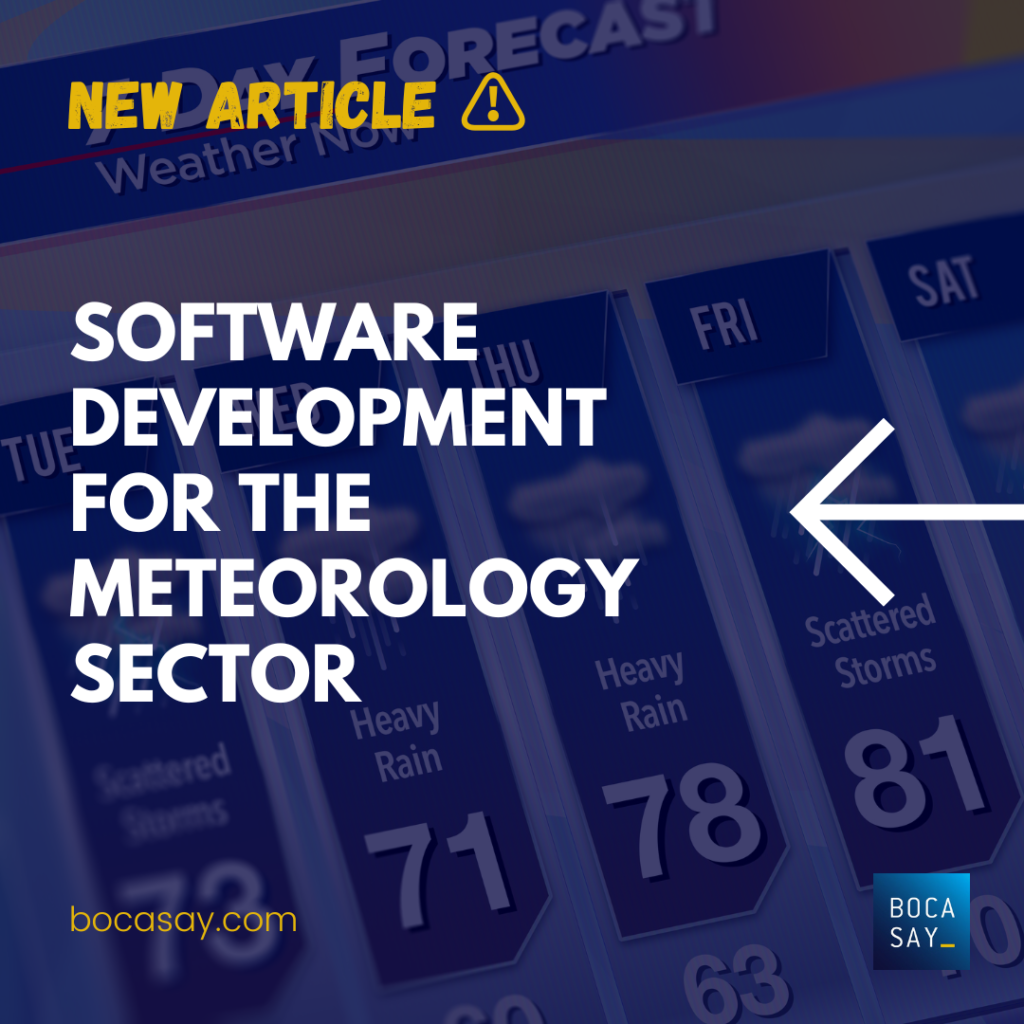Software Development for the Meteorology Sector
The development of weather software is essential today. It helps governments, businesses and individuals make informed decisions based on weather conditions. Weather software can also help prevent natural disasters and improve people’s quality of life.
In this article, Bocasay, an offshore outsourcing company, explains why the weather industry is in need of software innovation and provides an overview of the different weather forecasting software available on the market.

Why is Software Development in the Weather Sector Useful?
Software development in the weather sector is crucial to enable better understanding and accurate prediction of weather conditions. Companies and government agencies working in this sector need powerful software to collect and analyze weather data, as well as to provide accurate weather forecasts to consumers.
Software development for weather can include several aspects, such as:
- Data collection.
- Data analysis.
- Modeling.
- Visualization.
- Information dissemination.
Software development in the meteorological sector is useful for several reasons:
1. More accurate weather forecasts: Weather forecasting software uses sophisticated algorithms to process large amounts of weather data and produce more accurate forecasts. These forecasts can help governments, businesses and individuals make informed decisions about safety, risk management, agriculture, transportation and other areas.
2. Optimizing Operations: Businesses can use weather software to optimize their operations based on weather conditions. For example, transportation companies can use weather forecasts to plan vehicle routes and avoid weather-related delays.
3. Natural Disaster Prevention: Weather forecasting software helps governments prevent natural disasters such as floods, storms and droughts. Accurate weather forecasts also help governments take preventive measures such as evacuating areas at risk and building protective infrastructure.
4. Improved Quality of Life: Weather software helps individuals plan their daily activities based on weather conditions, which can improve their quality of life. For example, accurate weather forecasts allow farmers to plan their crops, athletes to plan their training and citizens to plan their travel.
ℕ𝕖𝕖𝕕 𝕒𝕟 𝕠𝕗𝕗𝕤𝕙𝕠𝕣 𝕠𝕦𝕥𝕤𝕠𝕦𝕣𝕔𝕚𝕟𝕘 𝕔𝕠𝕞𝕡𝕒𝕟𝕪? 𝔹𝕠𝕔𝕒𝕤𝕒𝕪 𝕕𝕖𝕧𝕖𝕝𝕠𝕡𝕤 𝕔𝕦𝕤𝕥𝕠𝕞 𝕤𝕠𝕗𝕥𝕨𝕒𝕣𝕖 𝕥𝕠 𝕞𝕖𝕖𝕥 𝕥𝕙𝕖 𝕤𝕡𝕖𝕔𝕚𝕗𝕚𝕔 𝕟𝕖𝕖𝕕𝕤 𝕠𝕗 𝕖𝕒𝕔𝕙 𝕔𝕝𝕚𝕖𝕟𝕥. 𝕋𝕙𝕚𝕤 𝕚𝕟𝕔𝕝𝕦𝕕𝕖𝕤 𝕤𝕠𝕗𝕥𝕨𝕒𝕣𝕖 𝕕𝕖𝕧𝕖𝕝𝕠𝕡𝕞𝕖𝕟𝕥 𝕗𝕠𝕣 𝕓𝕦𝕤𝕚𝕟𝕖𝕤𝕤𝕖𝕤, 𝕤𝕥𝕒𝕣𝕥𝕦𝕡𝕤 𝕒𝕟𝕕 𝕖𝕟𝕥𝕣𝕖𝕡𝕣𝕖𝕟𝕖𝕦𝕣𝕤 𝕚𝕟 𝕒 𝕧𝕒𝕣𝕚𝕖𝕥𝕪 𝕠𝕗 𝕗𝕚𝕖𝕝𝕕𝕤 𝕤𝕦𝕔𝕙 𝕒𝕤 𝕗𝕚𝕟𝕒𝕟𝕔𝕖, 𝕙𝕖𝕒𝕝𝕥𝕙𝕔𝕒𝕣𝕖, 𝕖𝕕𝕦𝕔𝕒𝕥𝕚𝕠𝕟, 𝕝𝕠𝕘𝕚𝕤𝕥𝕚𝕔𝕤 𝕒𝕟𝕕 𝕞𝕠𝕣𝕖. ℝ𝕖𝕢𝕦𝕖𝕤𝕥 𝕪𝕠𝕦𝕣 𝕗𝕣𝕖𝕖 𝕢𝕦𝕠𝕥𝕖!
Examples of Software Developed for the Meteorological Sector
DeepMind
DeepMind is a leading artificial intelligence research company that focuses on creating advanced AI algorithms to solve complex problems and improve the quality of life on a global scale.
The company has worked on projects in the weather field, using AI to improve weather forecasts. In 2019, the company announced a partnership with the British weather agency, the Met Office, to develop a more accurate and detailed weather forecasting system using machine learning.
The project, called Machine Learning for Weather, aims to create a high-resolution weather forecasting model capable of predicting weather events such as showers, thunderstorms and storms at more precise time and space scales. DeepMind is working with the Met Office to integrate its AI algorithms into existing weather forecasting systems.
DeepMind and the Met Office’s project aims to improve the accuracy of weather forecasts, which could have significant implications for weather-related planning and risk management, including for sectors such as transportation, agriculture, energy and security.
Meteo Group
MeteoGroup is a privately held company specializing in weather and climate forecasting services for business and government. Founded in 1986, MeteoGroup has offices in more than 15 countries in Europe, North America and Asia, and employs more than 400 people worldwide.
MeteoGroup’s services include customized weather forecasts for industries such as aviation, energy, transportation, agriculture, media and outdoor events. The company also offers weather monitoring services to help businesses manage weather risks such as flooding, storms, snow and ice.
MeteoGroup uses advanced numerical forecasting models, real-time weather observations and data processing algorithms to provide accurate and up-to-date weather forecasts for specific regions. The company is also committed to the research and development of new technologies and tools to improve the accuracy of weather forecasts in the future.
MeteoGroup is a global leader in customized weather forecasting services for businesses and governments, and continues to expand its portfolio of services to meet the needs of its customers.
NowCast
NowCast is a real-time weather forecasting system developed by the Met Office in partnership with weather technology start-up Biral. The system uses weather radar data, surface observations and numerical weather prediction models to provide accurate forecasts at very short notice (within the current hour).
The NowCast system uses machine learning techniques to combine real-time data to generate accurate, highly localized forecasts for weather events such as showers, thunderstorms and snowfall. NowCast forecasts are updated every five minutes to reflect the latest data and improve accuracy.
NowCast is used by a variety of industries, including aviation, transportation, agriculture and outdoor recreation, to help plan operations and manage weather-related risks. The system has won several awards for its technological innovation and practicality, and has become a benchmark for very short-range, real-time weather forecasting.

GRAF
GRAF (Global Rapid Analysis and Forecasting System) is a global weather forecasting system developed by the Met Office in collaboration with the US National Oceanic and Atmospheric Administration (NOAA). The system combines real-time weather observations from satellites, radars and land-based weather stations with numerical weather prediction models to provide high-resolution 10-day weather forecasts on a global scale.
The GRAF system uses advanced machine learning and data processing techniques to improve the quality and accuracy of weather forecasts. It is designed to be fast, accurate, and adaptable to changing weather conditions, making it a valuable tool for natural disaster management, business operations planning, and government decision-making.
The GRAF system is available to government agencies, businesses, and the general public via the Met Office weather portal. The system was launched in 2020 and has since been used to help predict weather events such as hurricanes, floods, and snowstorms on a global scale.
Conclusion
There are many weather forecasting software programs available, ranging from free tools available online, all the way to professional weather forecasting systems used by government agencies and businesses. These weather forecasting software programs use different numerical forecasting models, algorithms and analysis techniques to provide accurate weather forecasts for periods ranging from hours to days.


